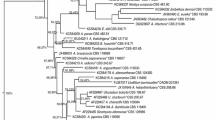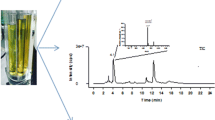Abstract
Antiplasmodial nortriterpenes with 3,4-seco-27-norlanostane skeletons, almost entirely obtained from fruiting bodies, represent the main evidential source for bioactive secondary metabolites derived from a relatively unexplored phytopathogenic fungus, Ganoderma boninense. Currently lacking is convincing evidence for antimicrobial secondary metabolites in this pathogen, excluding that obtained from commonly observed phytochemicals in the plants. Herein, we aimed to demonstrate an efficient analytical approach for the production of antibacterial secondary metabolites using the mycelial extract of G. boninense. Three experimental cultures were prepared from fruiting bodies (GBFB), mycelium cultured on potato dextrose agar (PDA) media (GBMA), and liquid broth (GBMB). Through solvent extraction, culture type-dependent phytochemical distributions were diversely exhibited. Water-extracted GBMB produced the highest yield (31.21 ± 0.61%, p < 0.05), but both GBFB and GBMA elicited remarkably higher yields than GBMB when polar-organic solvent extraction was employed. Greater quantities of phytochemicals were also obtained from GBFB and GBMA, in sharp contrast to those gleaned from GBMB. However, the highest antibacterial activity was observed in chloroform-extracted GBMA against all tested bacteria. From liquid-liquid extractions (LLE), it was seen that mycelia extraction with combined chloroform-methanol-water at a ratio of 1:1:1 was superior at detecting antibacterial activities with the most significant quantities of antibacterial compounds. The data demonstrate a novel means of assessing antibacterial compounds with mycelia by LLE which avoids the shortcomings of standardized methodologies. Additionally, the antibacterial extract from the mycelia demonstrate that previously unknown bioactive secondary metabolites of the less studied subsets of Ganoderma may serve as active and potent antimicrobial compounds.
Similar content being viewed by others
References
Abdel-Razek, A.S., El-Naggar, M.E., Allam, A., Morsy, O.M., and Othman, S.I. 2020. Microbial natural products in drug discovery. Processes 8, 470.
Abdullah, S., Ling, Y.S., Daim, S.J., Alexander, A., and Chong, K.P. 2018a. Ganoderma boninense isolated from Sabah, Malaysia exhibits potent antibacterial activity against clinically important bacterial pathogens. Bangladesh J. Pharmacol. 13, 10–12.
Abdullah, S., Ling, Y.S., Daim, S.J., and Chong, K.P. 2018b. Isolation and characterization of antibacterial compounds from Ganoderma boninense against methicillin-resistant Staphylococcus aureus (MRSA). Borneo J. Med. Sci. 1, 11–12.
Alexander, A., Dayou, J., Abdullah, S., and Chong, K.P. 2017. The changes of oil palm roots cell wall lipids during pathogenesis of Ganoderma boninense. Earth Environ. Sci. 77, 012014.
Archana, P., Samatha, T., Mahitha, B., and Chamundeswari, N.R. 2012. Preliminary phytochemical screening from leaf and seed extracts of Senna alata L. Roxb-an ethno medicinal plant. Int. J. Pharm. Biol. Res. 3, 82–89.
Ayoola, G.A., Coker, H.A.B., Adesegun, S.A., Adepoju-Bello, A.A., Obaweya, K., Ezennia, E.C., and Atangbayila, T.O. 2008. Phytochemical screening and antioxidant activities of some selected medicinal plants used for malaria therapy in Southwestern Nigeria. Trop. J. Pharm. Res. 7, 1019–1024.
Baby, S., Johnson, A.J., and Govindan, B. 2015. Secondary metabolites from Ganoderma. Phytochemistry 114, 66–101.
Boh, B., Berovic, M., Zhang, J., and Zhi-Bin, L. 2007. Ganoderma lucidum and its pharmaceutically active compounds. Biotechnol. Annu. Rev. 13, 265–301.
Brannan, D.K. 2006. Biology of microbes. In Geis, P.A. (ed.) Cosmetic Microbiology: A Practical Approach. 2nd edn., pp. 19–69. Taylor & Francis Group, New York, USA.
Bucar, F., Wube, A., and Schmid, M. 2013. Natural product isolation. how to get from biological material to pure compounds. Nat. Prod. Rep. 30, 525–545.
Chong, K.P., Eldaa, P.A., and Dayou, J. 2014. Relation of Ganoderma ergosterol content to Basal Stem Rot disease severity index. Adv. Environ. Biol. 8, 14–19.
Cör, D., Botić, T., Gregori, A., Pohleven, F., and Knez, Ž. 2017. The effects of different solvents on bioactive metabolites and “in vitro” antioxidant and anti-acetylcholinesterase activity of Ganoderma lucidum fruiting body and primordia extracts. Maced. J. Chem. Chem. En. 36, 129–141.
Daouda, T., Prevost, K., Gustave, B., Joseph, D.A., Nathalie, G., Raphael, O., Rubens, D., Claude, C.J., Mireille, D., and Felix, T. 2014. Terpenes, antibacterial and modulatory antibiotic activity of essential oils from Croton hirtus L’Her.(Euphorbiaceae) from ivory coast. J. Essent. Oil-Bear. Plants 17, 607–616.
Dwyer, J.R., Bandara, Y.M.N.D.Y., Whelan, J.C., Karawdeniya, B.I., and Nichols, J.W. 2017. Silicon nitride thin films for nanofluidic device fabrication. In Edel, J., Ivanov, A., and Kim, M. (eds) Nanofluidics, 2nd edn., pp. 190–236. Royal Society for Chemistry, Cambridge, United Kingdom.
Gao, Q.L., Guo, P.X., Luo, Q., Yan, H., and Cheng, Y.X. 2015. Petchienes A.E, Meroterpenoids from Ganoderma petchii. Nat. Prod. Commun. 10, 2019–2022.
Gong, T., Yan, R., Kang, J., and Chen, R. 2019. Chemical components of Ganoderma. In Lin, Z. and Yang, B. (eds.) Ganoderma and Health. Advances in Experimental Medicine and Biology, vol. 1181, pp. 59–106. Springer, Singapore.
Gonzalez, A., Atienza, V., Montoro, A., and Soriano, J.M. 2020. Use of Ganoderma lucidum (Ganodermataceae, Basidiomycota) as radioprotector. Nutrients 12, 1143.
Halbwachs, H., Simmel, J., and Bassler, C. 2016. Tales and mysteries of fungal fruiting: How morphological and physiological traits affect a pileate lifestyle. Fungal Biol. Rev. 30, 36–61.
Ho, C.L. and Tan, Y.C. 2015. Molecular defense response of oil palm to Ganoderma infection. Phytochemistry 114, 168–177.
Ismail, K., Abdullah, S., and Chong, K.P. 2014. Screening for potential antimicrobial compounds from Ganoderma boninense against selected food borne and skin disease pathogens. Int. J. Pharm. Pharm. Sci. 6, 771–774.
Jenkins, S.G. and Schuetz, A.N. 2012. Current concepts in laboratory testing to guide antimicrobial therapy. Mayo Clin. Proc. 87, 290–308.
Jensen, M.K. and Keasling, J.D. 2015. Recent applications of synthetic biology tools for yeast metabolic engineering. FEMS Yeast Res. 15, 1–10.
Jones, W.P. and Kinghorn, A.D. 2006. Extraction of plant secondary metabolites. In Sarker, S.D., Latif, Z., and Gray, A.I. (eds.), Natural products isolation. Methods in Biotechnology, vol. 20, pp. 323–351. Humana Press, New Sersey, USA.
Li, W., Chinthanom, P., Rachtawee, P., Intereya, K., Feng, T., Liu, J.K., and Isaka, M. 2018. Isolation of 3, 4-seco-27-norlanostane triterpenoids from cultivated fruiting bodies of Ganoderma orbiforme. Phytochem. Lett. 28, 104–109.
Li, P., Deng, Y.P., Wei, X.X., and Xu, J.H. 2013. Triterpenoids from Ganoderma lucidum and their cytotoxic activities. Nat. Prod. Res. 27, 17–22.
Ma, K., Li, L., Bao, L., He, L., Sun, C., Zhou, B., Si, S., and Liu, H. 2015. Six new 3,4-seco-27-norlanostane triterpenes from the medicinal mushroom Ganoderma boninense and their antiplasmodial activity and agonistic activity to LXRβ. Tetrahedron 71, 1808–1814.
Ma, K., Ren, J., Han, J., Bao, L., Li, L., Yao, Y., Sun, C., Zhou, B., and Liu, H. 2014. Ganoboninketals A.C, antiplasmodial 3,4-seco-27-norlanostane triterpenes from Ganoderma boninense pat. J. Nat. Prod. 77, 1847–1852.
Matos Lopes, T.R., de Oliveira, F.R., Malheiros, F.F., de Andrade, M.A., Monteiro, M.C., and Baetas Goncalves, A.C. 2015. Antimicrobial bioassay-guided fractionation of a methanol extract of Eupatorium triplinerve. Pharm. Biol. 53, 897–903.
Mohammed, C.L., Rimbawanto, A., and Page, D.E. 2014. Management of basidiomycete root- and stem-rot diseases in oil palm, rubber and tropical hardwood plantation crops. For. Path. 44, 428–446.
Mukherjee, J. 2015. Biotechnological Applications of Biodiversity. Springer, Berlin, Heidelberg, Germany.
Ng, S.Y., Abdullah, S., and Chong, K.P. 2013. Phytochemical constituents from leaves of Elaeis guineensis and their antioxidant and antimicrobial activities. Int. J. Pharm. Pharm. Sci. 5, 137–140.
Okada, B.K. and Seyedsayamdost, M.R. 2017. Antibiotic dialogues: induction of silent biosynthetic gene clusters by exogenous small molecules. FEMS Microbiol. Rev. 41, 19–33.
Olowe, O.A., Choudhary, S., Schierack, P., Wieler, L.H., Makanjuola, O.B., Olayemi, A.B., and Anjum, M. 2013. Pathotyping blaCTX-M Escherichia coli from Nigeria. Eur. J. Microbiol. Immunol. 3, 120–125.
Otsuka, H. 2006. Purification by solvent extraction using partition coefficient. In Sarjer, S.D., Latif, Z., and Gray, A.I. (eds.) Natural Products Isolation. Methods in Biotechnology, vol. 20. pp. 269–273. Humana Press, New Sersey, USA.
Peng, X.R., Liu, J.Q., Wang, C.F., Li, X.Y., Shu, Y., Zhou, L., and Qiu, M.H. 2014. Hepatoprotective effects of triterpenoids from Ganoderma cochlear. J. Nat. Prod. 77, 737–743.
Pilotti, C.A., Sanderson, F.R., and Aitken, E.A.B. 2002. Sexuality and interactions of monokaryotic and dikaryotic mycelia of Ganoderma boninense. Mycol. Res. 106, 1315–1322.
Qiao, B., Wu, J., Wan, Q., Zhang, S., and Ye, Q. 2017. Factors influencing mortality in abdominal solid organ transplant recipients with multidrug-resistant Gram-negative bacteremia. BMC Infect. Dis. 17, 171.
Raaman, N. 2006. Phytochemical Techniques. New India Publishing Agency, New Delhi, India.
Radhajeyalakshmi, R., Velazhahan, R., and Prakasam, V. 2012. In vitro evaluation of solvent extracted compounds from edible macromycetes against phytopathogenic fungi. Arch. Phytopathol. Pflanzenschutz 45, 293–300.
Rakib, M.R.M., Bong, C.F.J., Khairulmazmi, A., and Idris, A.S. 2015. Aggressiveness of Ganoderma boninense and G. zonatum isolated from upper- and basal stem rot of oil palm (Elaeis guineensis) in Malaysia. J. Oil Palm Res. 27, 229–240.
Richter, C., Wittstein, K., Kirk, P.M., and Stadler, M. 2015. An assessment of the taxonomy and chemotaxonomy of Ganoderma. Fungal Divers. 71, 1–15.
Saidana, D., Mahjoub, M.A., Boussaada, O., Chriaa, J., Cheraif, I., Daami, M., Mighri, Z., and Helal, A.N. 2008. Chemical composition and antimicrobial activity of volatile compounds of Tamarix boveana (Tamaricaceae). Microbiol. Res. 163, 445–455.
Seyd, A.H., Lanez, T., and Belfar, M.L. 2012. Modelling of yield and distribution coefficient in a liquid-liquid extraction: effect of the concentration of ligand. Asian J. Chem. 24, 4511–4516.
Sharma, C., Bhardwaj, N., Sharma, A., Tuli, H.S., Batra, P., Beniwal, V., Gupta, G.K., and Sharma, A.K. 2019. Bioactive metabolites of Ganoderma lucidum: factors, mechanism and broad spectrum therapeutic potential. J. Herb. Med. 17-18, 100268.
Sim, C.S.F., Cheow, Y.L., Ng, S.L., and Ting, A.S.Y. 2019. Antifungal activities of metal-tolerant endophytes against Ganoderma boninense under the influence of metal stress. Biol. Control 130, 9–17.
Sivanandhan, S., Khusro, A., Paulraj, M.G., Ignacimuthu, S., and Al-Dhabi, N.A. 2017. Biocontrol properties of basidiomycetes: an overview. J. Fungi (Basel) 3, 2.
Ulyshen, M.D. 2016. Wood decomposition as influenced by invertebrates. Biol. Rev. 91, 70–85.
Wang, K.F., Sui, K., Guo, C., and Liu, C.Z. 2017. Improved production and antitumor activity of intracellular protein-polysaccharide from Trametes versicolor by the quorum sensing moleculetyrosol. J. Funct. Foods 37, 90–96.
Xia, Q., Zhang, H., Sun, X., Zhao, H., Wu, L., Zhu, D., Yang, G., Shao, Y., Zhang, X., Mao, X., et al. 2014. A comprehensive review of the structure elucidation and biological activity of triterpenoids from Ganoderma spp. Molecules 19, 17478–17535.
Zengin, H. and Baysal, A.H. 2014. Antibacterial and antioxidant activity of essential oil terpenes against pathogenic and spoilageforming bacteria and cell structure-activity relationships evaluated by SEM microscopy. Molecules 19, 17773–17798.
Zhou, L.W., Cao, Y., Wu, S.H., Vlasák, J., Li, D.W., Li, M.J., and Dai, Y.C. 2015. Global diversity of the Ganoderma lucidum complex (Ganodermataceae, Polyporales) inferred from morphology and multilocus phylogeny. Phytochemistry 114, 7–15.
Acknowledgments
This research was supported by the Ministry of Education of Malaysia (FRGS0384-SG-2/2014). Syahriel Abdullah and Se-Eun Jang-Two contributed equally to this work and should be considered co-first authors.
Author information
Authors and Affiliations
Corresponding authors
Electronic supplementary material
Rights and permissions
About this article
Cite this article
Abdullah, S., Jang, SE., Kwak, MK. et al. Ganoderma boninense mycelia for phytochemicals and secondary metabolites with antibacterial activity. J Microbiol. 58, 1054–1064 (2020). https://doi.org/10.1007/s12275-020-0208-z
Received:
Revised:
Accepted:
Published:
Issue Date:
DOI: https://doi.org/10.1007/s12275-020-0208-z




